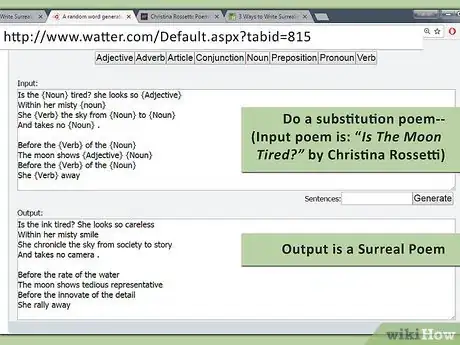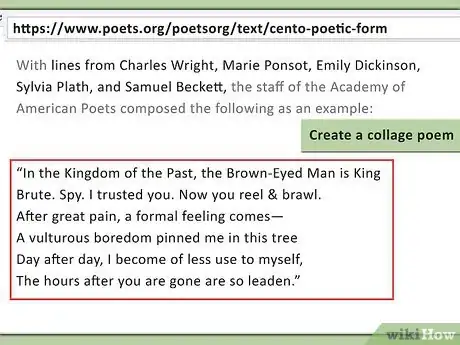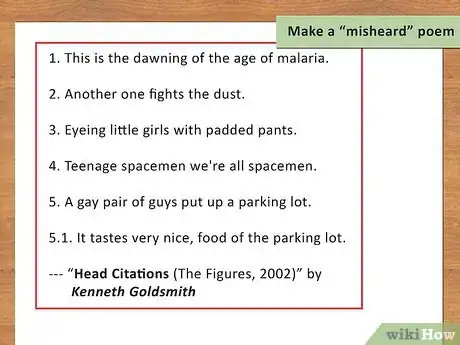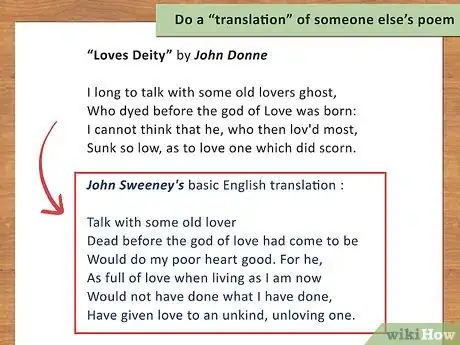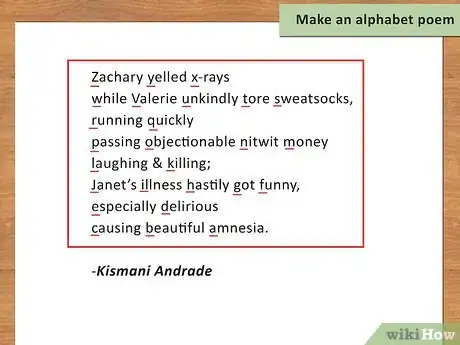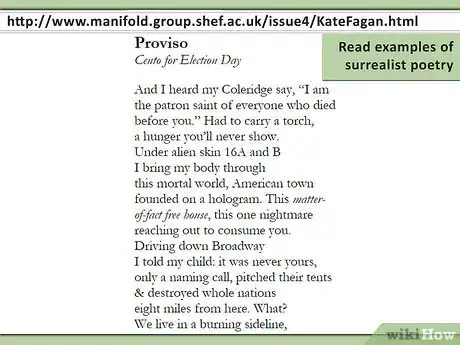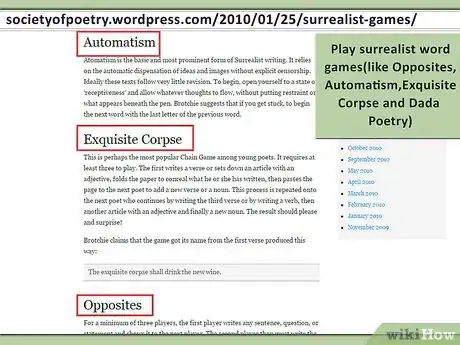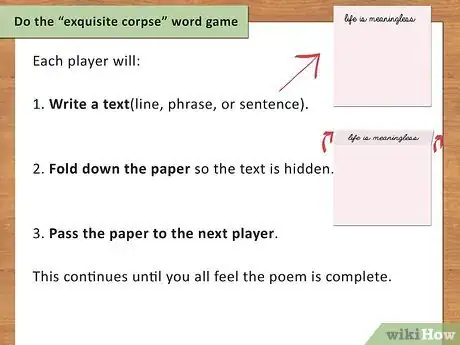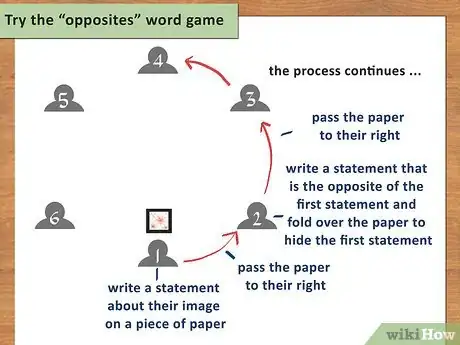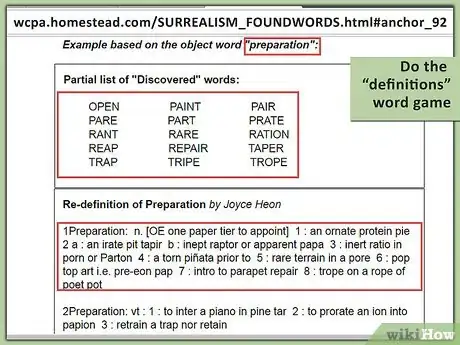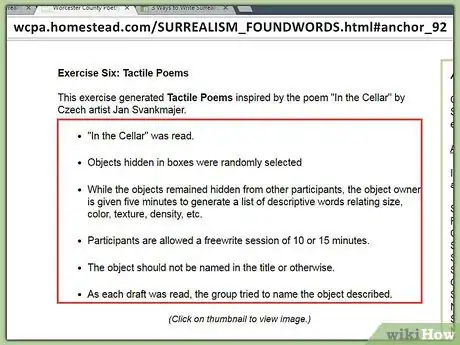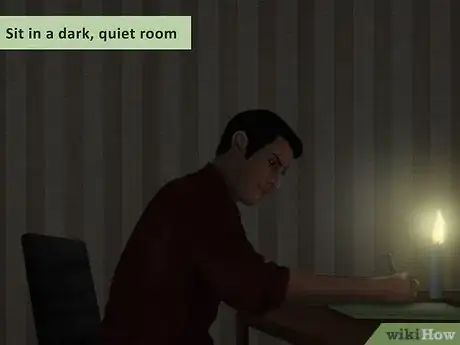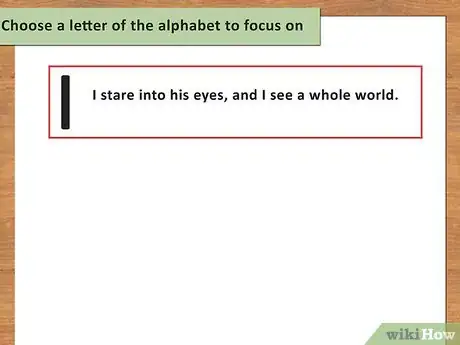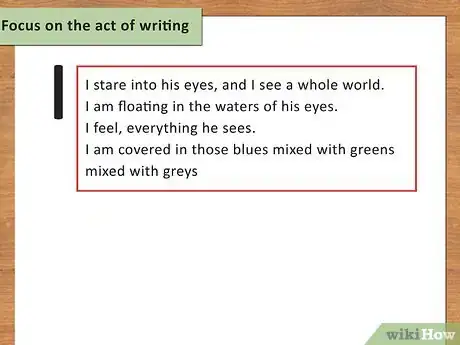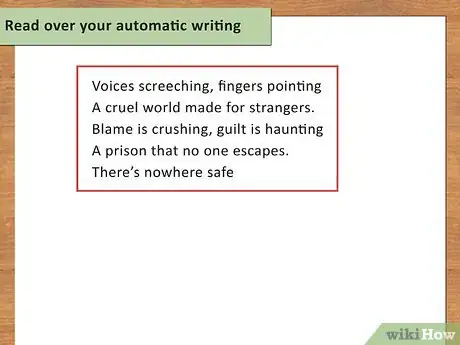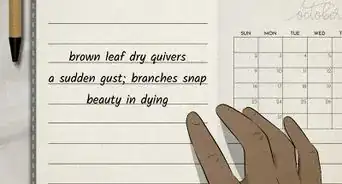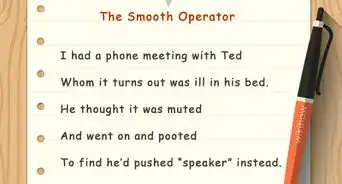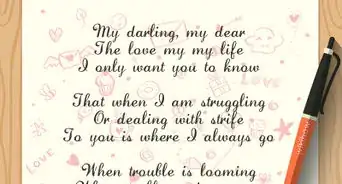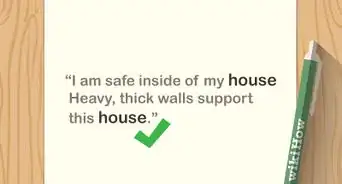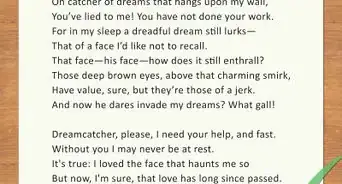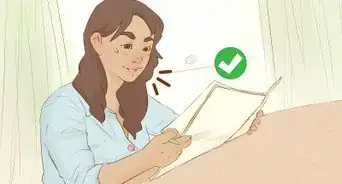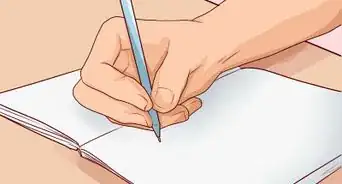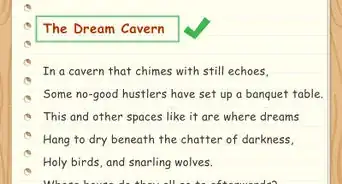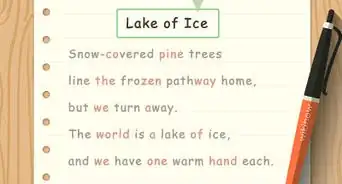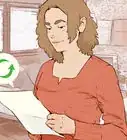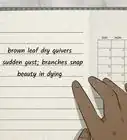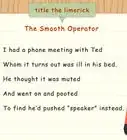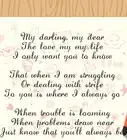This article was co-authored by wikiHow Staff. Our trained team of editors and researchers validate articles for accuracy and comprehensiveness. wikiHow's Content Management Team carefully monitors the work from our editorial staff to ensure that each article is backed by trusted research and meets our high quality standards.
There are 8 references cited in this article, which can be found at the bottom of the page.
This article has been viewed 24,861 times.
Learn more...
Surrealist poetry, an outgrowth of Symbolist poetry, emerged in late 19th-century Europe as a way to combine art, psychology, philosophy, and politics with writing.[1] This type of poetry allows the poet to freely and playfully experiment on the page. Surrealist poets use methods like writing prompts and word games to create poems that examine dreams, mental states, and repressed ideas in the mind. They also use a technique called automatic writing to write poetry. You can create your own surrealist poetry with some time and creativity.
Steps
Using Surrealist Poetry Prompts
-
1Do a substitution poem. You can try a popular surrealist poetry prompt called “substitution” to create your poem. This prompt requires you to use a source text, such as a poem that has already been published, your own poem, or another text that is at least one page long. You may use a source text like a medical text or an advertisement page as long as there is enough text on the page.[2]
- Start by taking the source text and putting blanks in place of three to four words in each line. Note the part of speech of each word under each blank, such as “present tense verb” or “present tense adjective.” Then, fill in the blanks without trying to recall the original content. You can also use a dictionary to randomly flip to words for the blanks or a random parts of speech generator online.
- Another way you can do a substitution is to do a “7 up or 7 down”. You would count 7 up or 7 down from the first word of the sentence and substitute that word. You may follow the same 7 up or 7 down pattern in the poem to create a system of substitution or do both options at the same time in the source text.
- You can also approach a substitution prompt by replacing words in the source text with words that exist in the text already. You may increase the number of words you replace in each line as you go through the text or decrease the number of words you replace.
-
2Create a collage poem. A collage poem, also called a cento poem, is made of phrases that have been lifted or sourced from other texts. You may use one source text or multiple source texts, such as magazines, advertisements, manuals, dictionaries, blogs, or newspapers. You could then pull one line from each source to create a collage poem.[3]
- Another way you can make a collage poem is to actually cut out the words in the source texts and paste them on to another page. You may choose a specific order for the cut out words or position them on the page at random.[4]
Advertisement -
3Make a “misheard” poem. This prompt is ideal if you are looking for ways to pull source material from things you hear. The idea is to write down things you mishear throughout the day, such as song lyrics, conversations, news headlines, menu items, and public service announcements.[5]
- You may sit in a public place, such as a busy park or a shopping plaza, and write down things you hear around you. Don’t worry about getting the details right, as you want to try to include things you mishear or words you hear incorrectly around you.
- You may then compile a list of misheard words and phrases from the day and position them in the form of a poem. You may repeat certain misheard words throughout the poem to create a pattern or organize them by the misheard words from the beginning of the day to misheard words at the end of the day.
-
4Do a “translation” of someone else’s poem. Another popular surrealist poetry prompt is doing playful “translations” of an existing text. You may take a published poem or a poem by a friend and translate it. You could also use a poem of your own, though you may find it challenging to distance yourself enough from the material to translate it.[6]
- Start by translating the poem from “English to English” by substituting a word for a word, a phrase for a phrase, and a line for a line. Create your own substitutions or use a dictionary to find synonyms for the existing words.
- You can also try translating the poem into another literary form, such as translating a sonnet into a free verse poem or a rhyming poem into a shape poem. You could also translate the poem into a different language, introducing slang or vernacular into the poem.
-
5Make an alphabet poem. You can try using the English alphabet as a prompt for a surrealist poem. This is a fun prompt that seems simple but can lead to some interesting results, especially if you want to write a long form poem.[7]
- You can start by writing down all 26 letters of the alphabet. Then, write a poem where each words begins with the letters of the alphabet, in sequence. For example, “A Baby Cow Died Every Friday…” You can also try starting each line of the poem with the letters of the alphabet, in sequence.
- Once you have written the alphabet poem following the alphabet in sequence, you can try going backwards or scrambling the letter order and writing a new poem with the new order.
-
6Read examples of surrealist poetry. You can find inspiration for your surrealist poetry by reading well known examples of the genre. Some of these surrealist poets use poetry prompts and some use word games. Several examples include:
Doing Surrealist Word Games
-
1Play surrealist word games to create poems. You can generate content for your surrealist poems by playing word games that are popular among surrealist poets. These games can act as prompts for your writing and also allow you to create content in a surrealist way.
- You may play several word games with other poets as part of a brainstorming session or play the games with a writing partner. You can also do one of these games as a warm up before a writing session on surrealist poetry to get your creative juices flowing.
-
2Do the “exquisite corpse” word game. This word game is a fun, popular way to create surrealist poetry. It is best done with at least one other person or two to four people. You can start the word game by choosing a word at random in a dictionary or by coming up with a word or phrase on your own.[12]
- You would then write the line, phrase, or sentence on the top of a sheet of paper. Then, fold down the paper so the text is hidden. Pass the paper to the player on the left.
- The next player is not allowed to view the first line. They will add a line inspired by the prompt and then fold down the paper to hide the first two lines. Then, they will pass the paper to the next player on the left.
- This continues until the paper has been passed to each player or until you all feel the poem is complete. Then, the starting person unfolds the poem and reads the finished work out loud.
-
3Try the “opposites” word game. This word game can be done using postcards with printed images on them. Try to choose images that can be open to interpretation. Place each image a folder or envelope and hand them out to the players.[13]
- Have the first player write a statement about their image on a piece of paper. Then, have the player pass the paper to their right. The next player will then write a statement that is the opposite of the first statement and fold over the paper to hide the first statement.
- The next player will then pass the paper to their right again and write a statement that contradicts the previous statement. Then, they will fold the paper so only the most recently written statement is visible.
- The starting player then adds a final line to the paper and reads out the finished opposites poem.
-
4Do the “definitions” word game. This word game is fun to play on your own or with several participants. You can create a deck of prompt words pulled from a source text or a dictionary. Try to use words that represent objects that might be strange or unfamiliar to the players.[14]
- Begin the game by selecting an “object word” from the deck of prompt words. Then, have all the players spend about five minutes compiling a list of possible words that could be found within the object word. Try to have 15 words per player for the object word.
- Share the “discovered” words with the players. Then, have the players create new definitions for the “object word” using the “discovered” words.
-
5Perform the “tactile” word game. This game will require you to hide different objects in boxes. Look for objects that have interesting textures and patterns. Set up five boxes with one object per box on a table. Make a small hole in the boxes so the players can place their hand in the box.[15]
- Allow each player to touch each object in the box. Then, give the players five minutes to create a list of descriptive words about each object. Make sure the players focus on describing the size, color, texture, and density of the objects.
- You can then have all players do a freewrite of one object for 10-15 minutes using the list of descriptive words. You can then have each player read out their freewrite. Each player has to guess what the object described is based on the freewrites.
Doing Automatic Writing
-
1Sit in a dark, quiet room. You should create a dark, quiet environment for the automatic writing session, free of distractions. Automatic writing is a popular surrealist technique that allows the writer to create text spontaneously, without overthinking or analyzing the text. This technique is supposed to help the writer access the subconscious mind.[16] [17]
- You can also put on music in the darkened room to help inspire your writing. You may choose classical music that could trigger certain emotions or feelings. Often choosing music without words can be less distracting during the writing sessions.
-
2Choose a letter of the alphabet to focus on. You may then choose a letter to begin the first line of the text or limit yourself to using a certain letter to start each sentence. If you are writing with others, you may all agree to use the same letter for the automatic writing session.[18]
- You can also use a writing prompt to get you started on the automatic writing session. You may set a timer for 10 to 15 minutes so you do not have to keep an eye on the time and can pay attention to just writing.
-
3Focus on the act of writing, rather than what you are writing down. Unlike traditional free-writing, automatic writing is all about trying to focus on the act of writing rather than what you are writing down on the page. Try to give yourself up to your subconscious and avoid reading back what you have written down or analyzing the words as you write.[19] [20]
- It may help to focus on the music playing the background to help distract your mind from trying to control your writing. Think about how the music sounds as you write and let the words simply flow on the page.
-
4Read over your automatic writing. Once your timer goes off, you should finish your last sentence. Then, read over your automatic writing. It may come across as gibberish or one long, strange sentence. Think about certain word combinations you made in a certain sentence or the sound of several lines when they are read together. Try to look for patterns, moments of strong description, and elements of a story or a character in the automatic writing.[21]
- Do not be too disappointed if you do not notice any clear images or a cohesive story in the writing. Automatic writing is more about letting your subconscious run free on the page and often you may be surprised or amused by the results.
References
- ↑ http://alangullette.com/essays/lit/surreal.htm
- ↑ http://www.writing.upenn.edu/bernstein/experiments.html
- ↑ http://www.writing.upenn.edu/bernstein/experiments.html
- ↑ http://wcpa.homestead.com/SURREALISM_FOUNDWORDS.html#anchor_71
- ↑ http://www.writing.upenn.edu/bernstein/experiments.html
- ↑ http://www.writing.upenn.edu/bernstein/experiments.html
- ↑ http://www.writing.upenn.edu/bernstein/experiments.html
- ↑ http://www.manifold.group.shef.ac.uk/issue4/KateFagan.html
- ↑ http://jacket2.org/commentary/jsweeneys-basic-english-donne
- ↑ http://www.epc.buffalo.edu/authors/goldsmith/soliloquy/index.html
- ↑ https://www.poets.org/poetsorg/poem/alphabet-poem
- ↑ http://wcpa.homestead.com/SURREALISM_FOUNDWORDS.html#anchor_71
- ↑ http://wcpa.homestead.com/SURREALISM_FOUNDWORDS.html#anchor_71
- ↑ http://wcpa.homestead.com/SURREALISM_FOUNDWORDS.html#anchor_71
- ↑ http://wcpa.homestead.com/SURREALISM_FOUNDWORDS.html#anchor_71
- ↑ http://alangullette.com/essays/lit/surreal.htm
- ↑ http://wcpa.homestead.com/SURREALISM_FOUNDWORDS.html#anchor_71
- ↑ http://wcpa.homestead.com/SURREALISM_FOUNDWORDS.html#anchor_71
- ↑ http://wcpa.homestead.com/SURREALISM_FOUNDWORDS.html#anchor_71
- ↑ http://alangullette.com/essays/lit/surreal.htm
- ↑ http://www.deathandtaxesmag.com/181227/surrealism-automatic-writing-the-politics-of-destroying-language/
